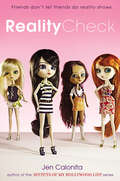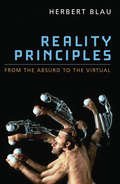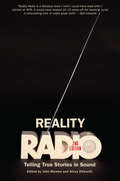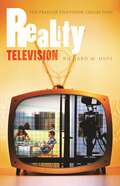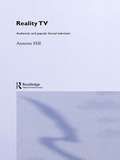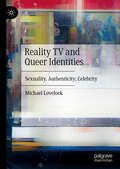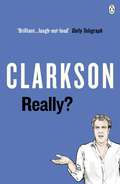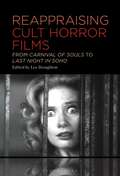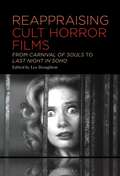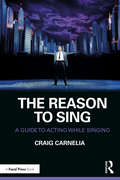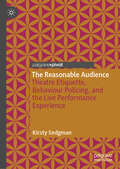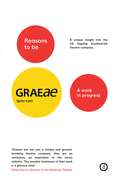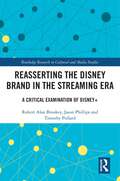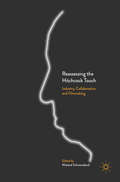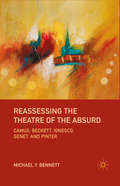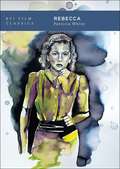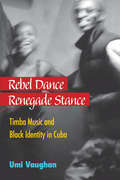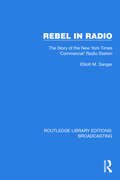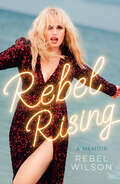- Table View
- List View
Reality Check
by Jen CalonitaSixteen-year-olds Charlie, Keiran, Brooke, and Hallie have just been signed up for their own reality television show. They can't even believe it. "You'll be The Hills meets The Secret Life of the American Teenager," the Armani-suited executive tells them, "and the hottest thing on our network." How could they say no? But soon enough, cameras following them everywhere and interfering producers surreptitiously scripting their lives start to affect the four best friends' relationship. Brooke seems to want all the screen time. Keiran is abruptly written out of the show-and consequently the group's friendship-when she doesn't rate well. As soon as Charlie realizes what's going on, she figures out the perfect way to give the studio and her home audience a much-needed reality check. Because friends don't let friends do reality shows.
Reality Principles: From the Absurd to the Virtual
by Herbert Blau“Herbert Blau’s long sustained inquiry into theater’s most provocative questions—presence, liveness, and finitude—are, at their deepest level, queries into life. Reality Principles returns us to Blau’s inspiring provocations and extends them to new subjects—9/11 and Ground Zero, the nature of charisma, Pirandello and Strindberg.” —Peggy Phelan, Stanford University Reality Principles gathers recent essays by esteemed scholar and theater practitioner Herbert Blau covering a range of topics. The book’s provocative essays—including “The Emotional Memory of Directing,” “The Faith-Based Initiative of the Theater of the Absurd,” “Virtually Yours: Presence, Liveness, Lessness,” “The Human Nature of the Bot”—were given as keynotes and/or memorial lectures and are collected here for the first time. The essays take up a remarkable array of topics—from body art and the self-inflicted punishments of Stelarc, Orlan, and the Viennese Actionists, to Ground Zero and 9/11—and allow Blau to address critical questions of theater and theory, performance and relevance, the absurd and the virtual, history and illusion, community and memory. Reality Principles offers a panoramic view of Herbert Blau’s perspectives on life and the imitation of life on stage.
Reality Radio, Second Edition: Telling True Stories in Sound (Documentary Arts and Culture, Published in association with the Center for Documentary Studies at Duke University)
by Alexa Dilworth John BiewenThis new revised and expanded edition of Reality Radio celebrates today's best audio documentary work by bringing together some of the most influential and innovative practitioners from the United States, Canada, the United Kingdom, and Australia. With a new foreword and five new essays, this book takes stock of the transformations in radio documentary since the publication of the first edition: the ascendance of the podcast; greater cultural, racial, and topical variety; and the changing economics of radio itself. In twenty-four essays total, documentary artists tell--and demonstrate, through stories and transcripts--how they make radio the way they do, and why. Whether the contributors to the volume call themselves journalists, storytellers, or even audio artists--and although their essays are just as diverse in content and approach--all use sound to tell true stories, artfully. Contributors include Jad Abumrad, Daniel Alarcon, Jay Allison, damali ayo, John Biewen, Emily Botein, Chris Brookes, Scott Carrier, Katie Davis, Sherre DeLys, Ira Glass, Alan Hall, Dave Isay, Natalie Kestecher, Starlee Kine, The Kitchen Sisters, Sarah Koenig and Julie Snyder, Maria Martin, Karen Michel, Joe Richman, Dmae Roberts, Stephen Smith, Alix Spiegel, Sandy Tolan, and Glynn Washington.Jad Abumrad, RadiolabDaniel Alarcon, Radio AmbulanteJay Allison, The Moth Radio Hour, Transom.orgdamali ayo, independent audio producerJohn Biewen, audio program director at CDS, Scene on RadioEmily Botein, vice president of On-Demand Content, WNYCChris Brookes, independent audio producer, Battery RadioScott Carrier, This American Life, Home of the BraveKatie Davis, special projects coordinator at WAMU, Neighborhood StoriesSherre DeLys, 360documentaries, ABC Radio National Ira Glass, This American LifeAlan Hall, independent audio producer, Falling Tree ProductionsDave Isay, StoryCorpsNatalie Kestecher, Pocketdocs, ABC Radio NationalStarlee Kine, Mystery ShowThe Kitchen Sisters, The Hidden World of Girls, Hidden Kitchens Sarah Koenig and Julie Snyder, SerialMaria Martin, Latino USA, GraciasVida Center for MediaKaren Michel, independent audio producerJoe Richman, Radio DiariesDmae Roberts, independent audio producerStephen Smith, APM ReportsAlix Spiegel, InvisibiliaSandy Tolan, independent audio producer, Homelands ProductionsGlynn Washington, Snap Judgment
Reality Television (The Praeger Television Collection)
by Richard M. HuffReality programming—a broad title for unscripted shows that involve non-actors—is really an updated version of a classic television genre that had its first successes decades before The Real World or Survivor made their premieres. NBC launched Try and Do It, a show in which audience members attempted to complete tasks such as whistling with a mouthful of crackers, in 1949. In the 1950s Queen for a Day crowned the most down-trodden of its four contestants, draping her in a sable-trimmed robe and granting a previously declared wish. The wild success reality television has achieved of late has pushed the envelope of such programming ever further away from the genre's innocuous beginnings. The time is now ripe for a look back on how this genre has developed, what it reveals about us, and what has transformed it into one of the most powerful forms of entertainment on television today.Reality programming—a broad title for unscripted shows that involve non-actors—is really an updated version of a classic television genre that had its first successes decades before The Real World or Survivor made their premieres. NBC launched Try and Do It, a show in which audience members attempted to complete tasks such as whistling with a mouthful of crackers, in 1949. In the 1950s Queen for a Day crowned the most down-trodden of its four contestants at the end of each show, draping her in a sable-trimmed robe and granting a previously declared wish. The wild success reality television has achieved of late has pushed the envelope of such programming ever further away—from the genre's innocuous beginnings. The time is now ripe for a look back on how this genre has developed, what it reveals about us, and what has transformed it into one of the most powerful forms of entertainment on television today.Using interviews with network insiders, reality producers, and other experts, Richard Huff supplies fascinating insights into the diverse content and often erratic development of reality television programming, augmenting this information with illuminating general connections between the past and present forms these shows assume. From Queen for a Day through Extreme Makeover, from Cops to Fear Factor, the genre is placed before us in this exhaustive and many-sided account, an account that uncovers the foundations and the future potential of the compelling and dominating phenomenon that is reality television.
Reality TV: Factual Entertainment and Television Audiences
by Annette HillReality TV restores a crucial, and often absent, element to the critical debate about reality television: the voices of people who watch reality programmes. From Animal Hospital to Big Brother, Annette Hill argues that much can be learned from listening to audience discussion about this popular and rapidly changing television genre. Viewers' responses to reality TV can provide invaluable information to enhance our understanding of both the reality genre and contemporary television audiences. Drawing on quantitative and qualitative audience research to understand how viewers categorise the reality genre, and how they judge the performance of ordinary people and the representation of authenticity within different types of reality programmes. * Do audiences think reality TV is real? * Can people learn from watching reality TV? * How critical are viewers of reality TV? Reality TV argues that audiences are engaged in a critical examination of the development of popular factual television. The book examines how audiences can learn from watching reality programmes, and how viewers think and talk about the ethics of reality TV.
Reality TV: Factual Entertainment and Television Audiences (Key Ideas In Media And Cultural Studies)
by Annette HillReality TV restores a crucial, and often absent, element to the critical debate about reality television: the voices of people who watch reality programmes. From Animal Hospital to Big Brother, Annette Hill argues that much can be learned from listening to audience discussion about this popular and rapidly changing television genre. Viewers' responses to reality TV can provide invaluable information to enhance our understanding of both the reality genre and contemporary television audiences. Drawing on quantitative and qualitative audience research to understand how viewers categorise the reality genre, and how they judge the performance of ordinary people and the representation of authenticity within different types of reality programmes. * Do audiences think reality TV is real? * Can people learn from watching reality TV? * How critical are viewers of reality TV? Reality TV argues that audiences are engaged in a critical examination of the development of popular factual television. The book examines how audiences can learn from watching reality programmes, and how viewers think and talk about the ethics of reality TV.
Reality TV and Queer Identities: Sexuality, Authenticity, Celebrity
by Michael LovelockThis book examines queer visibility in reality television, which is arguably the most prolific space of gay, lesbian, transgender and otherwise queer media representation. It explores almost two decades of reality programming, from Big Brother to I Am Cait, American Idol to RuPaul’s Drag Race, arguing that the specific conventions of reality TV—its intimacy and emotion, its investments in celebrity and the ideal of authenticity—have inextricably shaped the ways in which queer people have become visible in reality shows. By challenging popular judgements on reality shows as damaging spaces of queer representation, this book argues that reality TV has pioneered a unique form of queer-inclusive broadcasting, where a desire for authenticity, rather than being heterosexual, is the norm. Across all chapters, this book investigates how reality TV’s celebration of ‘compulsory authenticity’ has circulated ‘acceptable’ and ‘unacceptable’ ways of being queer, demonstrating how possibilities for queer visibility are shaped by broader anxieties and around selfhood, identity and the real in contemporary cultural life.
Really?: The World According To Clarkson (The\world According To Clarkson Ser.)
by Jeremy ClarksonCLARKSON'S BACK - AND HE'S REALLY HAD IT THIS TIME From his first job as a travelling sales rep selling Paddington Bears to his latest incarnation as gentleman farmer, Jeremy Clarkson's love of cars has seen him through some deeply trying times. And in a world so persistently infuriating there's sometimes nothing for it but to throw up your hands and ride full-throttle over the speed-bumps. But as Jeremy raced through there was plenty to ponder along the way, including: · Why nothing good has ever been achieved in a meeting · The side effects of muesli · How to navigate London when every single road is being dug up at once · Why we are forced to share the planet with people who read online reviews of dishwashers · And what, exactly, is the point of a driverless car? It's testing stuff, but happily Jeremy's not quite reached the end of his tether yet. Fuelled by hi-octane enthusiasm and irrepressible curiosity, he's put his foot down again. Seatbelts on . . ._________Praise for Jeremy Clarkson: Brilliant . . . Laugh-out-loud' Daily Telegraph'outrageously funny . . . Will have you in stitches' Time Out 'Very funny . . . I cracked up laughing on the tube' Evening Standard
Reappraising Cult Horror Films: From Carnival of Souls to Last Night in Soho
by Lee BroughtonIdentifies key – and in some cases previously overlooked – cult horror films from around the world and reappraises them by approaching and interrogating them in new ways.New productions in the horror genre occupy a prominent space within the cinematic landscape of the 21st century, but the genre's back catalogue of older films refuses to be consigned to the motion picture graveyard just yet. Interest in older horror films remains high, and an ever-increasing number of these films have enjoyed an afterlife as cult movies thanks to regular film festival screenings, television broadcasts and home video releases. Similarly, academic interest in the horror genre has remained high. The frameworks applied by contributors to the collection include genre studies, narrative theory, socio-political readings, aspects of cultural studies, gendered readings, archival research, fan culture work, interviews with filmmakers, aspects of film historiography, spatial theory and cult film theory. Covering a corpus of films that ranges from recognised cult horror classics such as The Wicker Man, The Shining and Candyman to more obscure films like Daughters of Darkness, The Legend of the 7 Golden Vampires, Shivers, Howling III: The Marsupials and Inside, Broughton has curated an international selection of case studies that show the diverse nature of the cult horror subgenre. Be they star-laden, stylish, violent, bizarre or simply little heard-of obscurities, this book offers a multitude of new critical insights into a truly eclectic selection of cult horror films.
Reappraising Cult Horror Films: From Carnival of Souls to Last Night in Soho
Identifies key – and in some cases previously overlooked – cult horror films from around the world and reappraises them by approaching and interrogating them in new ways.New productions in the horror genre occupy a prominent space within the cinematic landscape of the 21st century, but the genre's back catalogue of older films refuses to be consigned to the motion picture graveyard just yet. Interest in older horror films remains high, and an ever-increasing number of these films have enjoyed an afterlife as cult movies thanks to regular film festival screenings, television broadcasts and home video releases. Similarly, academic interest in the horror genre has remained high. The frameworks applied by contributors to the collection include genre studies, narrative theory, socio-political readings, aspects of cultural studies, gendered readings, archival research, fan culture work, interviews with filmmakers, aspects of film historiography, spatial theory and cult film theory. Covering a corpus of films that ranges from recognised cult horror classics such as The Wicker Man, The Shining and Candyman to more obscure films like Daughters of Darkness, The Legend of the 7 Golden Vampires, Shivers, Howling III: The Marsupials and Inside, Broughton has curated an international selection of case studies that show the diverse nature of the cult horror subgenre. Be they star-laden, stylish, violent, bizarre or simply little heard-of obscurities, this book offers a multitude of new critical insights into a truly eclectic selection of cult horror films.
The Reason to Sing: A Guide to Acting While Singing
by Craig CarneliaIn The Reason to Sing, renowned composer-lyricist and teacher Craig Carnelia provides musical actors with a step-by-step guide to making their singing performances more truthful, vivid, and full of life. Using a technique developed over decades of teaching the professional community of Broadway actors and students alike, The Reason to Sing utilizes detailed descriptions of sessions the author has had with his notable students and lays out a new and proven approach to help you build your skills, your confidence, and your career. This book is intended for musical theater acting students as well as working professionals and teachers of the craft.
The Reason to Sing: A Guide to Acting While Singing
by Craig CarneliaIn The Reason to Sing, renowned composer-lyricist and teacher Craig Carnelia provides musical actors with a step-by-step guide to making their singing performances more truthful, vivid, and full of life. Using a technique developed over decades of teaching the professional community of Broadway actors and students alike, The Reason to Sing utilizes detailed descriptions of sessions the author has had with his notable students and lays out a new and proven approach to help you build your skills, your confidence, and your career. This book is intended for musical theater acting students as well as working professionals and teachers of the craft.
The Reasonable Audience: Theatre Etiquette, Behaviour Policing, and the Live Performance Experience
by Kirsty SedgmanAudiences are not what they used to be. Munching crisps or snapping selfies, chatting loudly or charging phones onstage – bad behaviour in theatre is apparently on the rise. And lately some spectators have begun to fight back…The Reasonable Audience explores the recent trend of ‘theatre etiquette’: an audience-led crusade to bring ‘manners and respect’ back to the auditorium. This comes at a time when, around the world, arts institutions are working to balance the traditional pleasures of receptive quietness with the need to foster more inclusive experiences. Through investigating the rhetorics of morality underpinning both sides of the argument, this book examines how models of 'good' and 'bad' spectatorship are constructed and legitimised. Is theatre etiquette actually snobbish? Are audiences really more selfish? Who gets to decide what counts as ‘reasonable’ within public space?Using theatre etiquette to explore wider issues of social participation, cultural exclusion, and the politics of identity, Kirsty Sedgman asks what it means to police the behaviour of others.
Reasons to be Graeae: A work in progress
by Jenny SealeyGraeae is a force for change in world-class theatre, placing D/deaf and disabled actors centre stage and challenging preconceptions.A Work in Progress contains the full script of Reasons to be Cheerful, a brief history of the company, analysis and extracts from their previous shows, memories of Graeae from previous collaborators, including Jack Thorne, Jo Clifford, Kaite O’Reilly and Jonathan Meth, and a host of images.‘Graeae are not just a unique and groundbreaking theatre company; they are an institution, an inspiration to the entire industry. This overdue testimony of their work is a glorious read.’ Rufus Norris, Director of the National Theatre‘Graeae has always been a company in which radicalism and mischief have walked cheek by jowl. It’s a pleasure to see four decades of theatre celebrated.’ Lyn Gardner, The Guardian
Reasserting the Disney Brand in the Streaming Era: A Critical Examination of Disney+ (Routledge Research in Cultural and Media Studies)
by Robert Alan Brookey Jason Phillips Tim PollardReasserting the Disney Brand in the Streaming Era investigates the evolution of the Disney brand at a pivotal moment – the move from content creation to acquisition and streaming – and how the company reasserted its brand in a changing marketplace. Exploring how Disney’s acquisition of Pixar, Marvel, Lucasfilm and Fox positioned the company to launch the Disney+ streaming service, the chapters look at the history of those acquisitions, and the deployment of the content, brands and intellectual property from those acquisitions, through an analysis of the original content that appeared on Disney+. Offering a focused investigation of how the content offered from these various media brands was adapted for Disney+ so that it reflects the Disney brand, the authors illustrate through close textual analysis how this content reflects elements of the "Classic Disney Style." The analysis positions these texts in relation to their industrial contexts, while also identifying important touchstone texts (both television and film) in Disney's catalogue. This comprehensive and thoughtful analysis will interest upper-level students and scholars of media studies, political economy, Disney studies, media industries and new technology.
Reasserting the Disney Brand in the Streaming Era: A Critical Examination of Disney+ (Routledge Research in Cultural and Media Studies)
by Robert Alan Brookey Jason Phillips Tim PollardReasserting the Disney Brand in the Streaming Era investigates the evolution of the Disney brand at a pivotal moment – the move from content creation to acquisition and streaming – and how the company reasserted its brand in a changing marketplace. Exploring how Disney’s acquisition of Pixar, Marvel, Lucasfilm and Fox positioned the company to launch the Disney+ streaming service, the chapters look at the history of those acquisitions, and the deployment of the content, brands and intellectual property from those acquisitions, through an analysis of the original content that appeared on Disney+. Offering a focused investigation of how the content offered from these various media brands was adapted for Disney+ so that it reflects the Disney brand, the authors illustrate through close textual analysis how this content reflects elements of the "Classic Disney Style." The analysis positions these texts in relation to their industrial contexts, while also identifying important touchstone texts (both television and film) in Disney's catalogue. This comprehensive and thoughtful analysis will interest upper-level students and scholars of media studies, political economy, Disney studies, media industries and new technology.
Reassessing the Hitchcock Touch: Industry, Collaboration, and Filmmaking
by Wieland SchwanebeckThis volume is dedicated to the elusive category of the Hitchcock Touch, the qualities and techniques which had manifested in Alfred Hitchcock’s own films yet which cannot be limited to the realm of Hitchcockian cinema alone. While the first section of this collection focuses on Hitchcock’s own films and the various people who made important artistic contributions to them, the subsequent chapters draw wider circles. Case studies focusing on the branding effects associated with Hitchcockian cinema and its seductive qualities highlight the paratextual dimension of his films and the importance of his well-publicized persona, while the final section addresses both Hitchcock’s formative period, as well as other filmmakers who drew upon the Hitchcock Touch. The collection not only serves as an introduction to the field of Hitchcock scholarship for a wider audience, it also delivers in-depth assessments of the lesser-known early period of his career, in addition to providing new takes on canonical films like Vertigo (1958) and Frenzy (1972).
Reassessing the Hitchcock Touch: Industry, Collaboration, and Filmmaking
by Wieland SchwanebeckThis volume is dedicated to the elusive category of the Hitchcock Touch, the qualities and techniques which had manifested in Alfred Hitchcock’s own films yet which cannot be limited to the realm of Hitchcockian cinema alone. While the first section of this collection focuses on Hitchcock’s own films and the various people who made important artistic contributions to them, the subsequent chapters draw wider circles. Case studies focusing on the branding effects associated with Hitchcockian cinema and its seductive qualities highlight the paratextual dimension of his films and the importance of his well-publicized persona, while the final section addresses both Hitchcock’s formative period, as well as other filmmakers who drew upon the Hitchcock Touch. The collection not only serves as an introduction to the field of Hitchcock scholarship for a wider audience, it also delivers in-depth assessments of the lesser-known early period of his career, in addition to providing new takes on canonical films like Vertigo (1958) and Frenzy (1972).
Reassessing the Theatre of the Absurd: Camus, Beckett, Ionesco, Genet, and Pinter
by M. BennettFifty years after the publication of Martin Esslin's The Theatre of the Absurd , which suggests that 'absurd' plays purport the meaninglessness of life, this book uses the works of five major playwrights of the 1950s to provide a timely reassessment of one of the most important theatre 'movements' of the 20th century.
Rebecca (BFI Film Classics)
by Patricia WhiteThe 1940 film adaptation of Daphne du Maurier's gothic romance Rebecca begins by echoing the novel's famous opening line, 'Last night I dreamt I went to Manderley again.' Patricia White takes the theme of return as her starting point for an exploration of the film's enduring power. Drawing on archival research, she shows how the production and reception history of Rebecca, the first fruit of the collaboration between Hollywood movie producer David O. Selznick and British director Alfred Hitchcock, is marked by the traces of women's contributions. White provides a rich analysis of the film, addressing the gap between perception and reality that is constantly in play in the gothic romance, and highlighting the queer erotics circulating around 'I' (the heroine), Mrs Danvers, and the dead but ever-present Rebecca. Her discussion of the film's afterlives emphasizes the lasting aesthetic impact of this dark masterpiece of memory and desire, while her attention to its remakes and sequels speaks to the ongoing relevance of its vision of gender and power.
Rebecca (BFI Film Classics)
by Patricia WhiteThe 1940 film adaptation of Daphne du Maurier's gothic romance Rebecca begins by echoing the novel's famous opening line, 'Last night I dreamt I went to Manderley again.' Patricia White takes the theme of return as her starting point for an exploration of the film's enduring power. Drawing on archival research, she shows how the production and reception history of Rebecca, the first fruit of the collaboration between Hollywood movie producer David O. Selznick and British director Alfred Hitchcock, is marked by the traces of women's contributions. White provides a rich analysis of the film, addressing the gap between perception and reality that is constantly in play in the gothic romance, and highlighting the queer erotics circulating around 'I' (the heroine), Mrs Danvers, and the dead but ever-present Rebecca. Her discussion of the film's afterlives emphasizes the lasting aesthetic impact of this dark masterpiece of memory and desire, while her attention to its remakes and sequels speaks to the ongoing relevance of its vision of gender and power.
Rebel Dance, Renegade Stance: Timba Music and Black Identity in Cuba
by Umi VaughanRebel Dance, Renegade Stance shows how community music-makers and dancers take in all that is around them socially and globally, and publicly and bodily unfold their memories, sentiments, and raw responses within open spaces designated or commandeered for local popular dance. As an African American anthropologist, musician, dancer, and photographer who lived in Cuba, Vaughan reveals a unique perspective on contemporary Cuban society during the 1990s, the peak decade of timba, and beyond, as the Cuban leadership transferred from Fidel Castro to his brother. Simultaneously, the book reveals popular dance music in the context of a young and astutely educated Cuban generation of fierce and creative performers. By looking at the experiences of black Cubans and exploring the notion of “Afro Cuba,” Rebel Dance, Renegade Stance explains timba's evolution and achieved significance in the larger context of Cuban culture. Vaughan discusses a maroon aesthetic extended beyond the colonial era to the context of contemporary society; describes the dance spaces of Cuba; and examines the performance of identity and desire through the character of the “especulador.”
Rebel in Radio: The Story of the New York Times 'Commercial' Radio Station (Routledge Library Editions: Broadcasting #30)
by Elliott M. SangerRebel in Radio (1973) looks at the story of WQXR, the rebel New York commercial radio station. It examines WQXR’s place in broadcasting history, and how, at a time when American commercial radio had become but a pawn of the advertising industry, it showed that a radio station could be competitive and still maintain high programme and advertising standards.
Rebel in Radio: The Story of the New York Times 'Commercial' Radio Station (Routledge Library Editions: Broadcasting #30)
by Elliott M. SangerRebel in Radio (1973) looks at the story of WQXR, the rebel New York commercial radio station. It examines WQXR’s place in broadcasting history, and how, at a time when American commercial radio had become but a pawn of the advertising industry, it showed that a radio station could be competitive and still maintain high programme and advertising standards.
Rebel Rising: A Memoir
by null Rebel WilsonFrom the scene-stealing star of Pitch Perfect and Bridesmaids comes a refreshingly candid, hilarious and inspiring book about an unconventional journey to Hollywood success and self-celebration. For decades, Rebel Wilson single-mindedly focused on her career, forgoing relationships in favour of making a name for herself. In her revealing and authentic memoir, Rebel chronicles the emotional and physical lessons she has learned, as well as her most embarrassing experiences. A malaria-induced Oscars hallucination? An all-style martial-arts fighting tournament? Junior handling at dog shows? And this was all before she moved to Hollywood! Rebel Rising follows Rebel from her Aussie upbringing as the daughter of parents who sold pet products at dog shows, to making millions as LA’s favourite funny girl, always questioning "Am I good enough?”, "Will I ever find love?" and "Will I ever change and become healthy?". Rebel writes for the first time about the most personal and important moments in her life – from fertility issues, weight gain and loss to sexuality, overcoming shyness and dealing with rejection (and there's at least one story thrown in about Brad Pitt!). This brave and honest memoir shows us how to love ourselves while always remembering the value of laughing.
